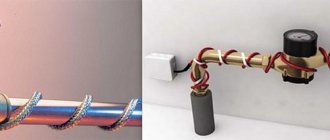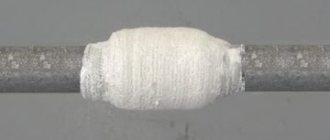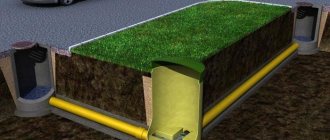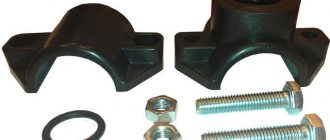Often underground communications are subjected to severe climatic tests. Therefore, defrosting sewers and heating pipes is one of the pressing issues for owners of private houses. In this article we will look at what leads to such consequences and what defrosting methods exist.
The operation of the sewer systems of a private home is associated with a lot of difficult situations. Harsh climatic conditions often lead to freezing of external pipelines. In such situations, the only solution is to defrost the sewer system, which can be used to restore the system’s functionality. The problem needs to be fixed as quickly as possible, so you have to do all the steps yourself. It is necessary to obtain information in advance about the causes of icing and how to eliminate the problem. The issue is important and requires careful consideration.
Why do pipes freeze?
No, this is not a rhetorical question. The reason often lies within ourselves. Yes, it is we, consciously or not, who violate the norms, and as a result, in the midst of a fierce winter, we get an unpleasant consequence in the form of an icy water supply or, even worse, a sewage system.
Pipes freeze for the following reasons:
- insufficient burial depth . Ideally, pipes should be located below the soil freezing level, and in some regions this level is at a depth of 1.8-2 m, or even deeper. Utilities and private developers sometimes do not adhere to this rule, either due to incorrect calculations or in attempts to save money;
- ineffective insulation . To prevent pipes from freezing in winter, it is necessary to insulate them, and those parts of the pipes that pass through the foundation or brick walls need double insulation, since these materials cool faster than the soil;
- It is better not to place pipes close to brick and concrete structures for the same reason. An exception is entry into the house;
- low water consumption . In private unheated houses, you cannot leave water in the pipes; it is better to drain it before winter;
- pipe diameter is too small . The smaller the diameter, the faster the liquid freezes. It is not recommended to lay water pipes with a diameter of less than 50 mm underground;
- Even if the depth of pipe laying is sufficient and they are well insulated, freezing may occur at extremely low temperatures that are not typical for the region. This is already an emergency situation.
If it so happens that the pipes are frozen and you will have to defrost them yourself, then first you will have to calculate the place where the water freezes. These can be outdoor areas or underground. Defrosting methods will vary.
So that nothing freezes...
But in any case, the problem of freezing and freezing will be easier to prevent than to fight it. If finances allow, then you can lay an electric cable through the pipe even at the stage of its installation. Then you can simply turn on the heating if necessary. But such pipes are not always cheap. And when installing an electrical system, you will need to have certain skills and access class.
Correct installation and insulation of pipes, taking into account temperature fluctuations in the region, will get rid of such a big problem as freezing of pipes.
So the simplest and most effective solution is:
- Measures for insulation of pipes at the installation stage. Today there is a large selection of different insulation materials on sale;
- Also, do not neglect maintaining the optimal depth for laying pipes. The depth may be different for different regions, so for this it is better to check the special tables;
- It will also be necessary to ensure the optimal angle of inclination of the pipe so that water can freely drain down. The optimal slope is 2 cm per meter of pipeline;
- When designing a sewer system, sharp bends and changes in direction should be avoided. It is in these places that ice accumulation is most often observed. If you can’t do without turning, then you need to install special inspection wells;
- When installing pipes, you must adhere to the following rule so that the joints follow the direction of water movement. Otherwise, it is at the joints - even in the smallest protrusions - that blockages will form, which, in turn, will serve as crystallizing centers for ice.
No. 1. Defrosting the pipe using a hair dryer or blowtorch
If the outer part of the pipe, which is within reach, is frozen , then the task is greatly simplified. It is enough just to expose the frozen area to external heating, and for this you can use:
- hair dryer, regular or construction;
- heating cable;
- heating pad;
- electric blanket.
If the pipe is metal, then you can also use the following heat sources:
- gas-burner;
- blowtorch;
- homemade torch.
The principle is the same in all cases. Heat is applied to the frozen area. If it’s a heating pad, then it’s applied; if it’s a cable, it’s used to wrap it around the pipe and plugged into the network; if it’s a burner or blowtorch, then the flame is directed into the pipe area, but with a hairdryer, everything is clear. An old blanket or thick cloth can be placed over the heating pad, heating cable, and thermal blanket to help retain heat.
It is important to open the water tap before starting work so that thawed water can flow out of the pipe calmly. The heater or heating boiler is turned off during this time.
From the point of view of professionals
Konstantin S., master plumber: You can prepare an effective solution for dissolving ice yourself. To do this, you only need kerosene or alcohol - you can take any. You will also need to dissolve quite a lot of salt to get a supersaturated solution.
Maxim Sereda, technologist: A steam generator is an extremely effective tool for combating ice inside any pipes. You can also build a device with your own hands. It represents a device with hollow walls, with two holes. To one you need to connect a hose of the required length made of heat-resistant material, and the other will serve for pouring water. This device works on all types of fuel.
No. 2. Defrosting using boiling water and a rag
The method is also suitable if the pipes are in the building and accessible . Of course, you can simply water the pipes with hot water, having previously placed containers to collect water, but it is much more effective to first wrap the pipes with rags, and only then give them a “hot shower”. The rag will absorb water, heat up and cause the pipes to be constantly exposed to heat. If there is only a small amount of rags, then it will need to be periodically moved along the pipe section. Don't forget to place a container to catch any water that won't be absorbed.
No. 3. Defrosting a pipe with a welding machine
If the frozen area is located outside the house , then it will take more time and effort to thaw. The method with a welding machine is considered one of the most effective, but it has a limitation - it is only suitable for metal pipes.
First, you will have to at least approximately determine the location of the formation of the ice plug . Then, on both sides, the water pipe is cleared of thermal insulation and polished to a metallic shine. An electric cable connected to the secondary winding is connected to these places .
Now all that remains is to set the minimum current on the device (about 180 A) and plug it into the network. The metal pipe will begin to heat up along the entire length of the connected section. Thawing occurs relatively quickly, but the duration of the entire process depends on the length of the pipe. At the same time, the water tap should also be kept open. Experts warn that the method has a side effect - pipes after such treatment begin to rust faster.
It is very important to connect and disconnect cables to the pipe only when the welding machine is turned off.
Otherwise, you can get an electric arc, which can damage both the pipe and your hands and eyes.
Conclusion
We have told you how to defrost a sewer pipe in several ways, each of them is effective if used in the appropriate conditions, so choose the most suitable option and fix the problem immediately. The video in the review will tell you additional information on the topic, and if you have a question, ask it in the comments below.
Previous post Budget and quick installation of a septic tank in a private house
Next entry Sewer pipes: types and applications
No. 4. Defrosting by supplying hot water through a hose
When the frozen area is in sight, it is enough to pour hot water directly on it. Through simple deductions, we can come to the conclusion that if the blockage is located far from the house, then it is necessary to somehow deliver hot water to the place of icing . Simply pouring hot water into the pipe is not very effective - you will have to get a little confused. This method is applicable to plastic pipes , when you cannot simply take and pass current through them, as through metal.
The procedure is as follows:
- remove shut-off valves;
- prepare a rigid hose or pipe with a diameter smaller than the water supply. For example, for a pipe with a diameter of 25-32 mm, a metal-plastic pipe with a diameter of 16 mm is suitable. This is if the section is completely straight. If there are turns and bends, then you will have to take a hose that can bend, but is also quite rigid. You cannot take a regular hose for watering - it may not withstand exposure to hot water and will soften, so it will be more difficult to push it through. You can take an oxygen hose or a hose that is usually used to connect gas cylinders. True, it can only be stretched 10-15 m from the input - it is too rigid and heavy. An alternative is to use a flexible hose with wire attached;
- insert the prepared hose or metal-plastic pipe into the pipe until you hit the ice;
- a container can be attached to the outer end of the hose from which hot water will be supplied. If you attach a faucet to it, it will be much more convenient. However, pour hot water through a funnel, but this is not very convenient;
- instead of simple hot water, you can use a salt solution - it freezes at a lower temperature, so the work will go faster;
- Melt water will flow out through the gap between the pipe or hose. Prepare a container for collecting it in advance
- as the ice plug melts, it will be possible the metal-plastic pipe or hose deeper .
When the work is completed, all that remains is to assemble the pipeline and install shut-off valves. To prevent re-freezing, ensure constant movement of water through the pipeline, at least with low pressure. The heating cable can be lowered into a straight pipe.
Hydro level method
A variation of this method is to use a construction hydraulic level of the required length. The method is suitable if there are 2-3 elbows in the pipe and the distance from the house to the frozen area is 20 m. A wire is tied to the end of the hydraulic level with electrical tape. Both need to be leveled a little in advance. There should be no wire sticking out from the end that will be immersed in the pipe. It is better to let it be 1 cm shorter than the hydraulic level.
The hydraulic level is pushed inside the pipe until it hits the ice . Hot water (or saline solution) can be supplied using an Esmarch mug, popularly known as an enema . When you hit the ice, you can start supplying water. To simplify, we give the pipe an enema. We collect the melt water in a basin or bucket, and as it thaws, we move the hydraulic level.
The good thing about this method is that the hydraulic level tube is quite thin, so it fits well into the water pipe, and it can easily navigate turns. Average speed – 1 meter of ice per hour .
The process of conservation of the sewer system
If you will not be at the dacha for 30 days or more, you cannot do without preserving VOCs. Moreover, this should be done before the first frost. Many people mistakenly believe that water needs to be drained from the system completely. However, if the reservoir is empty, it will deform or be pushed to the surface when the soil freezes or the groundwater level rises sharply during a flood.
If you bought a factory-made septic tank, follow the manufacturer's instructions to preserve the system correctly. All actions must be consistent, mistakes are unacceptable. If everything is done correctly, the temperature inside the system, even in cold weather, will be about 4 °C.
This is interesting!
Preserving a septic tank for the winter - is it necessary or not Read more
How to preserve a sewer system in a country house:
- In order for the organic sediment in the tank to be processed faster, colonies of microorganisms are added to it 14 days before cleaning the septic tank.
- Then the level of wastewater in the tank should be reduced to two-thirds of the volume. You may have to pump out the sludge or add water to the required level.
- After this, the system is disconnected from the power supply.
- To prevent damage to the tank, even if an ice crust forms on the surface of the wastewater at sub-zero temperatures, floats are placed in the septic tank. These can be two- or five-liter plastic bottles, partially filled with sand, with a cord attached to the necks. You need to pour enough sand so that the bottle is immersed in water to 2/3 of its height. In this case, its upper part should protrude above the drains. Due to the sand, the bottle will be positioned strictly vertically. When an ice crust forms, the plastic will shrink and the pressure on the walls of the septic tank will decrease. When the bottles are lowered into the container, the ropes should be tied so that when it gets warm, they can be removed.
- After this, the septic tank is closed with a lid.
- When living in the North, you should preserve the septic tank using heat-insulating material from the outside. For example, you can lay dry leaves, sawdust, moss or pine needles, straw. Then cover the insulation with polyethylene and press down the film with soil. To prevent aerobic microorganisms from dying, it is important to provide air flow. To do this, holes should be left in the film.
If you made a septic tank yourself, it will not have special devices to monitor and manage its operation. It is easy to preserve such a system; the main thing is to adhere to the described algorithm of actions. If everything is done correctly, an optimal temperature of about 4 °C will be maintained inside the tank.
No. 5. Defrosting with a wire
The method is suitable for defrosting only plastic water pipes located at a distance from the house. To work you should purchase:
- two-core wire, the length and thickness depends on the pipe, but people with experience advise taking a thicker and stiffer wire;
- socket plug;
- a compressor and a hose will be needed if the pipeline is long enough, or if the ice plug is located far from the point of entry into the house. You can buy a fuel hose, it is inexpensive, and use a pump as a compressor, or use a car compressor.
The main thing is to prepare the wire correctly . First, we remove the general insulation in an area of 8-10 cm and expose one of the wires. We carefully bend it in the opposite direction and make several turns (3-5 is enough) around the part that remains under the general insulation (it’s clear from the pictures below). The coils should be tight. The insulation is also removed from the second wire and wound below the turns of the first wire. The distance should be about 2-3 mm - the turns of the first and second wires should not touch. If you use pliers when creating turns, then first wrap the wire with something thick so as not to damage the insulation.
When the first end is ready, all that remains is to connect the plug from the second end. Here is our working tool, sometimes popularly called a “burbulyator”, ready. You shouldn’t try this method if you don’t understand much about electrics.
The action of this method is based on a simple physical phenomenon . When current passes through water, the latter heats up . Just what you need when you need to defrost pipes! It is important that the wire itself remains cold, only the water is heated, i.e. the likelihood of damaging the plastic pipe is minimized.
This method of defrosting frozen pipes can only be used if all parts (including shut-off valves) are made of plastic . If there are steel fittings, a short circuit may occur.
check if our defrost is working using a jar of water . It is enough to lower one end of the wire there, plug the other into the socket, and you will see bubbles begin to appear in the water, all this will be accompanied by a hum. You shouldn't put your fingers in the water - you might get an electric shock.
Now all that remains is to lower the wire into the pipe until it hits the ice, but without unnecessary force. We plug it into the socket, carefully press the end of the wire against the ice and wait a couple of minutes, after which you can try to lower the wire a little more; it will seem to fall into the ice on its own. If the frozen area is large enough, then it is better to gradually pump out the melted water. You can do without this, but then it will take more time, because you will also have to heat up a sufficient amount of water. There is another threat - the ice that has already melted may begin to freeze while you melt its deeper layers. In general, it is better to use a pump or compressor.
No. 6. How to defrost a sewer pipe?
Let us note right away that sewer pipes freeze much less often than water pipes , and this is a solid reason for joy. The fact is that warm wastewater continuously moves through them, but if it suddenly happens that the sewer system is frozen, try one of the following methods:
- if we are talking about a private house, and the sewer pipe is located shallow, then you can over the supposed frozen area . It will warm up the soil, and then the runoff. The process is lengthy; the fire will have to be maintained until the sewage system fully grows;
- if the ice plug is located near the outlet of the toilet or sink, try pouring a hot concentrated salt solution into the pipe (1 kg of salt per 10 liters of water). Such a solution freezes at a temperature of -220C , so it can melt the ice in the pipe;
- insert a heating cable into the pipe through the inspection hatch or toilet drain hole ;
- if other methods did not help, you will have to supply hot water to the place of ice plug formation through a hose, metal-plastic pipe or hydraulic level.
The method is described above. The most obvious drawback is that melted sewage can flow back . If a section of the pipe near the drain collector is frozen, then it is better to supply water not from the side of the house.
If independent attempts to defrost water supply and sewerage pipes are unsuccessful, then you can only rely on specialists who use special steam generators. These devices resemble car washing machines, only the output is steam, and its temperature and pressure can be adjusted depending on the material of the pipes and the length of the frozen area. This method is very fast and effective.
What you need to know before starting work
PVC pipes for external sewerage
Defrosting sewer pipes can be done in different ways. The choice of one method or another will depend on several factors. Namely:
- the material from which the pipes are made;
- plug size;
- removing ice dam from home.
You can use a blowtorch to heat cast iron and metal pipes
Sewer pipes can be made of metal or plastic. The first option (which is not so common today) makes it possible to use the external heating method. Plastic pipes cannot be heated; at best, they will withstand temperatures up to 100°C.
The size and location of the ice plug can be determined using a thick metal wire. It is introduced first from the side of the house, and then from the side of the cesspool or septic tank. Knowing the length of the entire communication and the depth of penetration of the wire, you can easily calculate the location and size of the ice plug.











